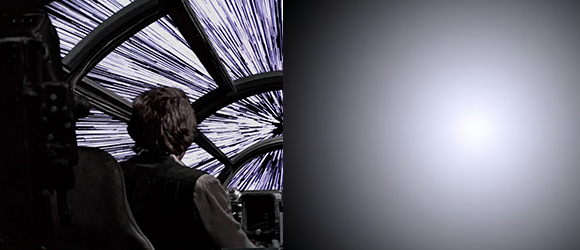Also, there is just no way you can measure Force sensitivity with a blood test. I refuse to accept that. George Lucas, you’ve tricked me for the last time.
Physics students at the University of Leicester took it upon themselves to discover what the view from a spaceship traveling near the speed of light would actually look like. And… well, it’s the right side of the image up above. Just a blurry circular gradient. Bummer.
Discovery explains the science like so:
[Similar to the Doppler Effect,] the visible light emitted from the stars ahead becomes compressed as we speed forward. The wavelength gets shorter and shorter the more we accelerate. Very quickly, we’ll see the light moved through the blue part of the visible light spectrum and then through the ultraviolet. The electromagnetic radiation from the stars no longer belongs in the visible spectrum, so our eyes can no longer detect the light. At close to the speed of light, the once-visible light (from our frame of reference) gets pushed into the X-ray part of the spectrum, making the galaxy ahead of us dark.
But, like with most astronomy-related discoveries, there’s an aspect of this that’s really freaking amazing. If approaching light speed makes normally visible light “blueshift” into darkness… what’s that white light in the middle there? That would be the universe’s background radiation, aka “the primordial glow of the Big Bang,” which is normally invisible but would blueshift into something we can see upon approaching light speed. You’d literally be seeing something from the birth of our universe. How cool is that?
Pretty cool, is the answer. Almost cool enough to make me not bitter that traveling at faster-than-light speeds doesn’t make you go plaid like in Spaceballs. Almost.
(via: Discovery)
Are you following The Mary Sue on Twitter, Facebook, Tumblr, Pinterest, & Google +?








Published: Jan 17, 2013 02:00 pm